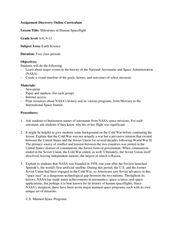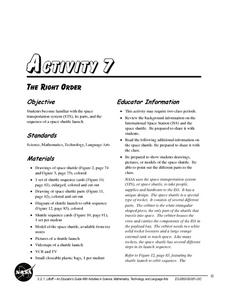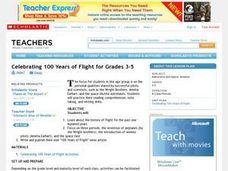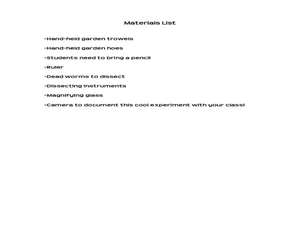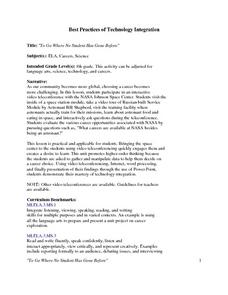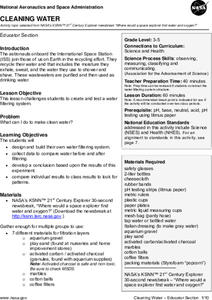Curated OER
Astronauts Train in Deep-Space Brine
Students examine an article on astronauts training in deep space brine then discuss what they learned. For this investigative lesson students get into groups and design an exercise that includes isolation, silence and conflict resolution.
Curated OER
Soybeans in Space
Students work together to design an experiment that compares and contrasts differnet plant cultivation systems. In groups, they evaluate the results of the experiment to discover if the cultivation system could be used in space. They...
National Nanotechnology Infrastructure Network
Taking a Closer Look at Objects
Take a close look at the world around you with an activity that magnifies everyday objects. Five explorations examine items under intense magnification and pose a series of questions that encourage critical thinking and following...
Curated OER
The Big Arm
In this "The Big Arm" activity, students answer multiple choice questions about "The Big Arm" and the space shuttle that launched it. Students complete 4 questions.
Curated OER
Physics of Space Flight
In this space flight activity, students will review physics terms relating to space which includes measuring the distance of space objects, how rockets work, and electromagnetic waves. This activity has 10 terms in a crossword puzzle, 6...
Curated OER
Milestones in Human Spaceflight
Students investigate the history and goals of NASA and human spaceflight. In this space science lesson, students answer questions about one of seven manned space programs and print pictures from the mission. As a class, students will...
Curated OER
The Right Order
Pupils investigate the Space Transportation System and the sequence of a space shuttle launch. They view and discuss photos, watch a video of a shuttle launch, and place shuttle launch cards in the correct order.
Curated OER
To Boldly Go Where No One Has Gone Before
Students study pictures of space vehicles and make their own space vehicle. In this space vehicle lesson, students study pictures of the vehicles and compare and contrast the pictures. Students classify the space crafts and then create...
Curated OER
Robot Earth
Students construct a simple robotic energy transformer. For this space science lesson, students explain how energy is transformed from one form to another. They identify the different uses of robotic devices.
Alabama Learning Exchange
Men and Women of Space Exploration
Fourth graders research famous astronauts. In this space science instructional activity, 4th graders list famous astronauts and use reference materials and the Internet to write a report on them.
Curated OER
Celebrating 100 Years of Flight for Grades 3-5
Students study the history of flight of the past one hundred years, focusing on the invention of the airplane, the introduction of women pilots and the space race. They conduct research and then write and publish a "100 Years of Flight"...
NASA
Supernova Chemistry
By measuring the wavelength, frequency, and intensity of electromagnetic radiation, scientists determine the temperature, density, and composition of far away items. Scholars rotate through ten lab stations using a spectroscope at each...
International Technology Education Association
Pixel This!
Did the image I drew match the image you saw? By simulating a satellite and a ground station, teams of two transmit data in the form of pixels in order to recreate an image. They use four different levels of brightness, creating slightly...
CK-12 Foundation
Relative Velocity Simulation
If your pupils think relative velocity is the velocity at which you can run away from your relatives, they need this simulation. Two bikers want to meet at a specific time. Scholars alter the velocity of one rider to arrange the...
Curated OER
Classification of Matter
This is a great instructional activity with an infographic to assist your high schoolers in categorizing matter into mixtures and non-mixtures. Information is given about the metric system of measurement. Your young students match 13...
Curated OER
Artificial Gravity
In this scientific investigation worksheet, students follow the provided procedures to observe gravity as they build a paper space station and then respond to 4 short answer questions.
Curated OER
What Wavelength Was That?
A combination of informative text, photos, and graphics comprise this sharp show on electromagnetic radiation. Some slides mention hands-on activities for demonstrating concepts, so if you want to include them you will need to figure out...
Curated OER
Where We've Been and Where We're Going
Students travel with Christa McAuliffe through space demonstrations. In this space lesson, students follow through the past to the present air travel. Students understand the benefits and problems associated with zero gravity and how it...
Curated OER
A Science Trail: Worms
Third graders explore worms in multiple ways. In this lesson on worms, 3rd graders search for worms in their natural environment, record data on worms, and dissect worms.
Curated OER
Simple Rocket Science
Students demonstrate Newton's Third Law of Motion. They discuss the history of rockets, observe how a rocket works, and draw a picture and write an explanation of the balloon experiment.
Curated OER
To Go Where No Student Has Gone Before
Eighth graders participate in interactive video teleconference with employees of NASA Johnson Space Center. Students visit inside of space station module, take video tour of Russian-built Service Module by Astronaut Bill Shepherd, visit...
K5 Learning
What Is A Spacewalk?
Read about all the jobs astronauts do and all the responsibilities they have while on a spacewalk. After reading the what, the why, and the how about spacewalks, readers respond to six comprehension questions.
NASA
Cleaning Water
Give young scientists a new appreciation of fresh, clean drinking water. After learning about the ways astronauts recycle their air and water, your class will work in small groups creating and testing their very own water filtration...
Curated OER
Analyzing the Relationship between Snowpack and River Flow
Young scholars use the Internet to research current and past snowpack levels and river gauging station readings. They determine the relationship between snowpack and river flow. They predict future river flow.







